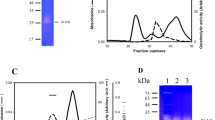Summary
SPARC (secreted protein acidic and rich in cysteine), also known as osteonectin and BM-40, is a secreted protein associated with a variety of embryonic and adult tissue and cell types, including placenta, parietal and visceral endoderm, certain epithelia (e.g. gut, skin, glandular epithelia), and regions of active chondrogenesis and osteogenesis. Although much is known concerning the tissue distribution of this protein, neither the time and location of its initial appearance nor its functions during embryogenesis have been clearly established. We identified the location of SPARC on two-dimensional protein gels. By using two-dimensional gel analysis of both pre- and post-implantation stage mouse embryos, we find that SPARC is initially synthesized between 3.5 and 4.5 days of embryogenesis. This is the earliest time during development at which synthesis of SPARC has been demonstrated. Inner cell masses isolated from 4.5 day blastocysts synthesize SPARC indicating that either primitive ectoderm, primitive endoderm, or both produce this protein. SPARC synthesis is also detectable in isolated trophoblast vesicles. Thus, SPARC is synthesized not only in placenta, parietal endoderm, and visceral endoderm, but in the precursors of these tissues as well. Examination of 7.5 day embryos reveals that SPARC is synthesized in isolated parietal yolk sac and in whole extraembryonic and embryonic regions. Relative to other proteins, synthesis of SPARC was most prevalent in the parietal yolk sac. The possible implications of SPARC synthesis as early as 4.5 days are discussed.
Similar content being viewed by others
References
Abrumczuk J, Solter D, Koprowski H (1977) The beneficial effect of EDTA on development of mouse one-cell embryos in chemically defined medium. Dev Biol 61:378–383
Bolander ME, Young MF, Fisher LW, Yamada U, Termine J (1988) Osteonectin cDNA sequencing reveals potential binding regions for calcium and hydroxyapetite and shows homologies with both a basement membrane protein (SPARC) and a serine protease inhibitor (ovomucoid). Proc Natl Acad Sci USA 85:2919–2923
Cattanach BM, Kirk M (1985) Differential activity of maternally and paternally derived chromosome regions in mice. Nature Lond 315:496–498
Gardner RL (1982) Investigation of cell lineage and differentiation in the extraembryonic endoderm of the mouse embryo. J Embryol Exp Morphol 68:175–198
Gardner RL (1983) Origin and differentiation of extra-embryonic tissues in the mouse. Int Rev Pathol 24:63–133
Garrels JI, Franza RB (1989) The REF52 protein database. J Biol Chem 264:5283–5298
Hogan B, Costantini F, Lacy E (1986) Manipulating the mouse embryo: a laboratory manual. Cold Spring Harbor Laboratory, New York, p 276
Holland PWH, Harper SJ, McVey JH, Hogan BLM (1987) In vivo expression of mRNA for the Ca-binding protein SPARC (osteonectin) revealed by in situ hybridization. J Cell Biol 105:473–482
Howe CC, Kath R, Mancianti ML, Herlyn M, Mueller S, Cristofalo V (1990) Expression and structure of human SPARC transcripts: SPARC mRNA is expressed by human cells involved in extracellular matrix production and some of these cells show an unusual expression pattern. Exp Cell Res 188:185–191
Howe CC, Overton GC, Sawicki J, Solter D, Stein P, Strickland S (1988) Expression of SPARC/osteonectin transcript in murine embryos and gonads. Differentiation 37:20–25
Laemmli UK (1970) Cleavage of structural proteins during the assembly of the head of bacteriophage T4. Nature Long 227:680–685
Mason IJ, Murphy D, Munke M, Francke U, Elliot RW, Hogan BLM (1986a) Developmental and transformation-sensitive expression of the SPARC gene on mouse chromosome 11. EMBO J 5:831–1837
Mason IJ, Taylor A, Williams JG, Sage H, Hogan BLM (1986b) Evidence from molecular cloning that SPARC, a major product of mouse embryo parietal endoderm, is related to an endothelial cell “culture shock” glycoprotein of Mr 43000. EMBO J 5:1465–1472
O'Farrell PH (1975) High resolution two-dimensional electrophoresis of proteins. J Biol Chem 250:4007–4021
Pierce GB (1966) The development of basement membranes of the mouse embryo. Dev Biol 13:231–249
Sage H, Tupper J, Bramson P (1986) Endothelial cell injury in vitro is associated with increased secretion of an Mr 43000 glycoprotein ligand. J Cell Physiol 127:373–387
Sage H, Vernon RB, Decker J, Funk S, Iruela-Arispa ML (1989a) Distribution of the calcium-binding protein SPARC in tissue of embryonic and adult mice. J Histochem Cytochem 37:819–829
Sage H, Vernon RB, Funk SE, Everitt EA, Angelo J (1989b) SPARC, a secreted protein associated with cellular proliferation, inhibits cell spreading in vitro and exhibits calcium-dependent binding to the extracellular matrix. J Cell Biol 109:341–356
Solter D, Knowles BB (1975) Immunosurgery of mouse blastocyst. Proc Natl Acad Sci USA 72:5099–5102
Speicher D (1989) Microsequencing with PVDF membranes: efficient electroblotting, direct protein adsorption, and sequencer program modifications. In: T Hugli (ed) Techniques in protein chemistry. Academic Press, San Diego, CA, pp 24–35
Termine JD, Kleinman HK, Whitson SW, Cohn KM, McGarvey ML, Martin GR (1981) Osteonectin, a bone-specific protein linking mineral to collagen. Cell 26:99–105
Author information
Authors and Affiliations
Rights and permissions
About this article
Cite this article
Latham, K.E., Howe, C.C. SPARC synthesis in pre-implantation and early post-implantation mouse embryos. Roux's Arch Dev Biol 199, 364–369 (1991). https://doi.org/10.1007/BF01705929
Received:
Accepted:
Issue Date:
DOI: https://doi.org/10.1007/BF01705929




